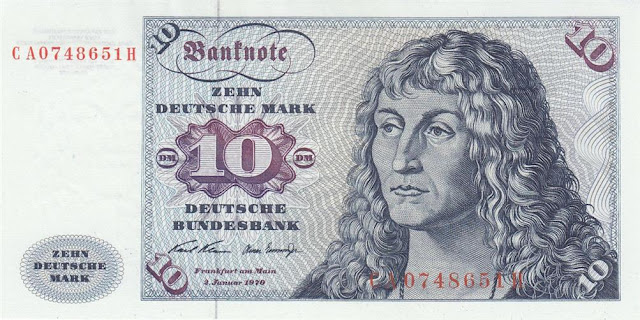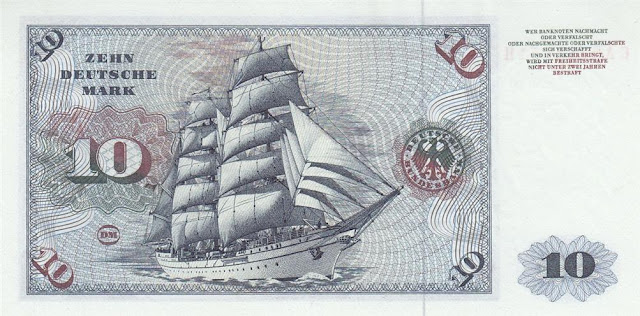 |
| German banknotes10 DM Deutsche Mark |
 |
| German banknotes10 Deutsche Mark - German barque Gorch Fock |
German Money 10 Deutsche Mark banknote of 1970, issued by Deutsche Bundesbank
Deutschmark or Deutsche Mark - DM the former standard monetary unit of Germany.
German banknotes, German mark banknotes, Deutsche Mark, German paper money, German bank notes, Germany banknotes, Germany paper money, Germany bank notes, German currency, German East African banknotes, German Rentenmark.Obverse: Portrait of a Young Man by Albrecht Dürer.
Reverse: German Navy's training ship Gorch Fock (1958) under full sails.
Germany banknotes - Germany paper money
Deutsche Bundesbank - German Federal Bank
1960-1980 issue
The third series of German mark banknotes was introduced in 1960 by the Bundesbank, depicting neutral symbols, paintings by the German painter Albrecht Dürer, and buildings. There were 5 Deutsche Mark, 10 Deutsche Mark, 20 Deutsche Mark, 50 Deutsche Mark, 100 Deutsche Mark, 500 Deutsche Mark and 1000 Mark denominations.
5 Deutsche Mark 10 Deutsche Mark 20 Deutsche Mark 50 Deutsche Mark
100 Deutsche Mark 500 Deutsche Mark 1000 Deutsche Mark
100 Deutsche Mark 500 Deutsche Mark 1000 Deutsche Mark
Gorch Fock (1958)
The Gorch Fock is a tall ship of the German Navy (Deutsche Marine). She is the second ship of that name and a sister ship of the Gorch Fock built in 1933. Both ships are named in honour of the German writer Johann Kinau who wrote under the pseudonym "Gorch Fock" and died in the battle of Jutland/Skagerrak in 1916. The modern-day Gorch Fock was built in 1958 and has since then undertaken 146 cruises (as of October 2006), including one tour around the world in 1988. She is sometimes referred to (unofficially) as the Gorch Fock II to distinguish her from her older sister ship. The Gorch Fock is under the command of the Naval Academy in Flensburg-Mürwik.
The Gorch Fock was depicted on the 10 DM banknote of the third series (1960–1990) issued by the Bundesbank and is therefore one of the most portrayed ships in the world.
The ship
Germany lost all of its school ships as war reparations after World War II to the Allies, so the West German Bundesmarine decided in 1957 to have a new training vessel built following the plans for the original Gorch Fock of 1933 which by that time was owned by the Soviets, and renamed to Tovarishch. The new ship was a modernized repeat of the Albert Leo Schlageter, a slightly modified sister ship of the previous Gorch Fock.
The 1933 Gorch Fock had already been designed to be a very safe ship: she had a righting moment large enough to bring her back into the upright position even when heeling over to nearly 90°. Nevertheless some last-minute changes to the design were made in response to the Pamir disaster in 1957, especially concerning the strength of the body and the bulkheads as well as the lifesaving equipment, including the lifeboats.
The new ship was built by Blohm & Voss in Hamburg, launched on 23 August 1958, and commissioned on 17 December of that year. Her home port is Kiel. The Gorch Fock is a three-masted barque with a steel hull 81.2 m (266 ft) long (without the bowsprit) and 12 m (40 ft) wide. She has a draught of some 5.2 m (17 ft) and a displacement at full load of 1760 tons. Originally, she carried 1952 m² of canvas sails; later, she received slightly larger sails made of synthetic materials. The tops of her fore and main masts can be lowered so that she can navigate the Kiel Canal, otherwise she would be too tall for some of the bridges spanning the canal. Officially Gorch Fock is a Type 441 class naval ship with the NATO pennant number A60. Her international radio call sign is DRAX.
Over the years, various modernizations have been applied to the ship. She was fitted with air conditioning, the asbestos used originally was removed and replaced by less dangerous materials in 1991, and in that year she also received a new auxiliary engine, a six cylinder diesel engine producing 1,220 kW (1660 hp), giving the ship a top speed of 13.7 knots under power. The interior has also been modified multiple times; technological advances made it possible to reduce the size of the galley and enlarge the crew quarters.
In 2016 major modernisation and repair commenced by the German shipyard Elsflether Werft, expected to cost some 75 million euros. In 2017 it was assessed that the amount of work required was much greater, including the almost complete replacement of the hull plating, renewal of decks and refurbishment of the engine with a cost then estimated at 135 million euros. In January 2018 work was stopped while a review was carried out by the Ministry of Defence, including consideration of replacing Gorch Fock with a new vessel. In March 2018 it was announced that the project would continue, noting that a new building would not be delivered until 2025, and that the existing vessel would re-enter service in 2019.
The cruises
The Gorch Fock has been in German Navy service as a training ship since 1958. Since she has been commissioned, more than 14,500 cadets have been trained on the Gorch Fock. The Gorch Fock participates in sailing parades and Tall Ships' Races, where she is in amicable rivalry with the Italian vessel Amerigo Vespucci. Other ships of the same class include the USCGC Eagle, Sagres, Gorch Fock (1933) and Mircea. The Gorch Fock can host up to 350 passengers on board.
In 1987-88, she sailed around the world, with stopovers on five continents. Lasting 336 days, this was her second longest cruise, topped only by a training cruise in 1996-97 from Kiel to Bangkok and back that lasted 343 days.
During the last 50 years, at least six sailors have died in accidents aboard the Gorch Fock, either by falling from the rigging or by going overboard. Recent fatalities include an 18-year-old officer-candidate who went overboard at night in the North Sea on 3 September 2008. On 7 November 2010, an officer-candidate perished when she fell from the rigging. The accident happened during an exercise while the ship was moored in the port of Salvador da Bahia (Brasil). In the aftermath of the latest accident, naval cadets refused to climb the rigging (the highest position on the main mast being at 45 metres), and four of them were subsequently accused of "inciting rebellion". This was described as a mutiny in some accounts. Subsequently, officers' training on board the Gorch Fock was suspended, pending a thorough review of training protocols and indeed the entire training program. According to a 19 November 2010 statement issued by the German Fleet Command, the officer candidates then on board were to be flown back to Germany to continue their training while the ship was docked in Ushuaia, Argentina. The commanding officer was suspended, and a commission was appointed to investigate claims of sexual harassment and improper conduct. On 13 March 2011, all charges against the commanding officer were dismissed.
Deutsche Mark
The Deutsche Mark (German mark, abbreviated "DM") was the official currency of West Germany (1948–1990) and unified Germany (1990–2002) until the adoption of the euro in 2002. It is commonly called the "Deutschmark" in English but not in German. Germans often say "Mark" or "D-Mark". It was first issued under Allied occupation in 1948 replacing the Reichsmark, and served as the Federal Republic of Germany's official currency from its founding the following year until 1999, when the mark was replaced by the euro; its coins and banknotes remained in circulation, defined in terms of euros, until the introduction of euro notes and coins in early 2002. The Deutsche Mark ceased to be legal tender immediately upon the introduction of the euro—in contrast to the other Eurozone nations, where the euro and legacy currency circulated side by side for up to two months. Mark coins and banknotes continued to be accepted as valid forms of payment in Germany until 28 February 2002.
The Deutsche Bundesbank has guaranteed that all German marks in cash form may be changed into euros indefinitely, and one may do so at any branch of the Bundesbank in Germany. Banknotes can even be sent to the bank by mail.
On 31 December 1998, the Council of the European Union fixed the irrevocable exchange rate, effective 1 January 1999, for German mark to euros as DM 1.95583 = €1.
One Deutsche Mark was divided into 100 Pfennig.
The third series of German mark banknotes was introduced in 1960 by the Bundesbank, depicting neutral symbols, paintings by the German painter Albrecht Dürer, and buildings. There were 5 Deutsche Mark, 10 Deutsche Mark, 20 Deutsche Mark, 50 Deutsche Mark, 100 Deutsche Mark, 500 Deutsche Mark and 1000 Mark denominations.